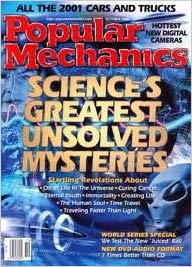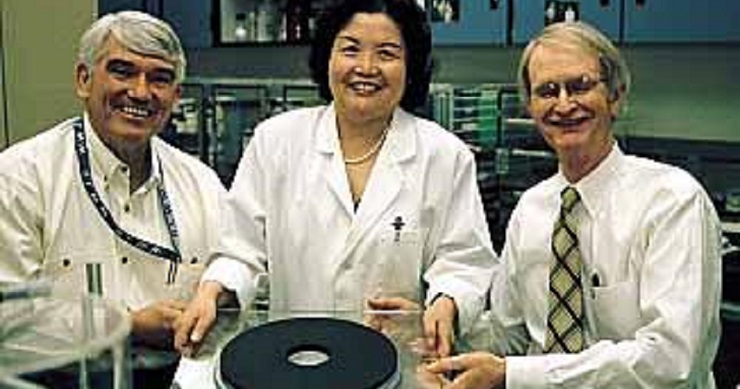Taming Gravity
 By Jim Wilson
By Jim Wilson
Popular Mechanics
Photo by Phillip Gentry
Ever since electricity was tamed in the 19th century, the idea of manipulating gravity by altering an electromagnetic field has been the subject of intriguing experiments and occasional bursts of irrational exuberance. Physicists insist that because gravity is a basic force of nature, constructing an antigravity machine is theoretically impossible. But recently, and not without some reluctance, they have begun to consider another possibility. Several highly respected physicists say it might be possible to construct a force-field machine that acts on all matter in a way that is similar to gravity. Strictly speaking, it wouldn’t be an antigravity machine. But by exerting an attractive or repulsive force on all matter, it would be the functional equivalent of the impossible machine.
While an operational device is at least five years in the future, developers of what can be loosely termed a force-field machine say it has cleared major theoretical hurdles. To demonstrate their claim, they invited POPULAR MECHANICS to visit their Huntsville, Ala., laboratory to see the most important component of their proof-of-concept demonstrator. It is a 12-in.-dia. high-temperature superconducting disc (HTSD). When the force-field machine is complete, a bowling ball placed anywhere above this disc, which resembles a clutch plate, will stay exactly where you left it.
Everyone knows that gravity is the glue that keeps our feet on the ground and the planets on their orbits. It operates on every single molecule and atom in our bodies. Physicists define gravity as the attractive force between two masses. They also say it is the weakest and most pervasive of the four basic forces of nature. The others are the strong force and weak force that operate within the atomic nucleus and the electromagnetic force that explains everything from refrigerator magnets to light bulbs, telecommunications to chemistry.
Machines that use electromagnetism to defy gravity have a checkered history. In 1911, Edward S. Farrow, a New York engineer, staged public demonstrations of a weight-reducing device he called a condensing dynamo. In all likelihood it was no more than an electromagnet, a small version of the behemoths that lift wrecks into junkyard crushers. Earlier this year, BAE Systems, a major British aerospace company, announced that it had taken up the gravity quest with an initiative called Project Greenglow. The mainstream physics community immediately dropped a load of wet blankets on the defense contractor, claiming it was wasting money on a bad idea.
The Einstein Connection
Prospects for the Alabama HTSD are attracting serious attention because this particular disc was fabricated by Ning Li, one of the world’s leading scientists. In the 1980s, Li predicted that if a time-varying magnetic field were applied to superconductor ions trapped in a lattice structure, the ions would absorb enormous amounts of energy. Confined in the lattice, the ions would begin to rapidly spin, causing each to create a minuscule gravitational field.
To understand how an HTSD is critical to the construction of a force-field machine, it’s useful to know something about an unusual state of matter called a Bose-Einstein condensate. In our day-to-day lives we encounter three states of matter: solid, liquid and gas. In the laboratory it is possible to create another state of matter in which all the atoms are aligned in a way that makes them behave as if they were one single atom. This novel state of matter is named after Albert Einstein and Indian physicist Satyendra Nath Bose who predicted its existence decades ago.
In an HTSD, the tiny gravitational effect of each individual atom is multiplied by the billions of atoms in the disc. Using about one kilowatt of electricity, Li says, her device could potentially produce a force field that would effectively neutralize gravity above a 1-ft.-dia. region extending from the surface of the planet to outer space.
A/C Gravity
“The first thing to understand about Li’s device is that it is neither an antigravity machine nor a gravitational shield,” says Jonathan Campbell, a scientist at the NASA Marshall Space Flight Center who has worked with Li. “It does not modify gravity, rather it produces a gravity-like field that may be either attractive or repulsive.” Li describes her device as a method of generating a never-before-seen force field that acts on matter in a way that is similar to gravity. Since it may be either repulsive or attractive she calls it “AC gravity.” “It adds to, or counteracts, or re-directs gravity,” explains Larry Smalley, the former chairman of the University of Alabama at Huntsville (UAH) physics department. “Basically, you are adding a couple of vectors to zero it [gravity] out or enhance it.”
Although he didn’t call it AC gravity, Einstein’s theory of relativity predicts this effect. All objects produce gravito-magnetic energy, the amount of force proportional to its mass and acceleration. Li says that the main reason this energy has never been detected is that the Earth spins very slowly and the field’s strength decreases rapidly as you move away from the center of the planet. The first measurements are expected to be made by NASA’s Gravity Probe B experiment, which is planned for launch in 2002.
Beginning with the most basic law of physics–force = mass x acceleration–Li reasoned that it would be possible to perform the same experiment here on Earth, using ions locked in a lattice structure inside a superconductor. When an ion rotates around a magnetic field, the mass goes along for the ride. This, according to Einstein, should produce a gravito-magnetic field.
Unlike the planet, ions have a minuscule mass. But also unlike the Earth, they spin their little hearts out, rotating more than a quadrillion times a second, compared with the planet’s once-a-day rotation. Li calculates this movement will compensate for the small mass of the ions.
Li explains that as the ions spin they also create a gravito-electric field perpendicular to their spin axis. In nature, this field is unobserved because the ions are randomly arranged, thus causing their tiny gravito-electric fields to cancel out one another. In a Bose-Einstein condensate, where all ions behave as one, something very different occurs.
Li says that if the ions in an HTSD are aligned by a magnetic field, the gravito-electric fields they create should also align. Build a large enough disc and the cumulative field should be measurable. Build a larger disc and the force field above it should be controllable. “It’s a gravity-like force you can point in any direction,” says Campbell. “It could be used in space to protect the international space station against impacts by small meteoroids and orbital debris.”
Concept To Machine
Although Li’s theory has passed through the scientific quality-control process called peer review and an HTSD has been constructed, important technical unknowns remain. This summer, Li left UAH. She and several colleagues are striking out on their own to commercialize devices based on her theory and a proprietary HTSD fabrication technique.
Li’s next step is to raise the several million dollars needed to build the induction motor that individually spins the ions in the HTSD. “It will take at least two years to simulate the machine on a computer,” says Smalley, who plans to join Li’s as-yet-unnamed company after he retires from UAH. “We want to avoid the situation that occurred in fusion where extremely expensive reactors were built, turned on, and didn’t work as intended because of unforeseen plasma instabilities.” Li says she has turned down several offers for financial backing. It is less about money than control. “Investors want control over the technology,” she says.
“This is too important. It should belong to all the American people.”
Relevant Content:
- All Things Dr. Ning Li (Taming Gravity Tag)
- Engineering Taming Gravity (Menu Tab)
References:
- Taming Gravity by Jim Wilson (Google Archives)
- TheLivingMoon.com/TamingGravity


Leave a Reply